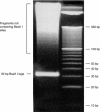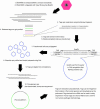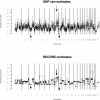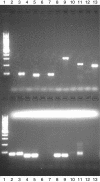Genomic representations using concatenates of Type IIB restriction endonuclease digestion fragments
- PMID: 15329383
- PMCID: PMC516078
- DOI: 10.1093/nar/gnh120
Genomic representations using concatenates of Type IIB restriction endonuclease digestion fragments
Abstract
We have developed a method for genomic representation using Type IIB restriction endonucleases. Representation by concatenation of restriction digests, or RECORD, is an approach to sample the fragments generated by cleavage with these enzymes. Here, we show that the RECORD libraries may be used for digital karyotyping and for pathogen identification by computational subtraction.
Figures





References
-
- Saha S., Sparks,A.B., Rago,C., Akmaev,V., Wang,C.J., Vogelstein,B., Kinzler,K.W. and Velculescu,V.E. (2002) Using the transcriptome to annotate the genome. Nat. Biotechnol., 20, 508–512. - PubMed
-
- Velculescu V.E., Zhang,L., Vogelstein,B. and Kinzler,K.W. (1995) Serial analysis of gene expression. Science, 270, 484–487. - PubMed
-
- Spinella D.G., Bernardino,A.K., Redding,A.C., Koutz,P., Wei,Y., Pratt,E.K., Myers,K.K., Chappell,G., Gerken,S. and McConnell,S.J. (1999) Tandem arrayed ligation of expressed sequence tags (TALEST): a new method for generating global gene expression profiles. Nucleic Acids Res., 27, e22. - PMC - PubMed
-
- Wang T.L., Diaz,L.A.,Jr, Romans,K., Bardelli,A., Saha,S., Galizia,G., Choti,M., Donehower,R., Parmigiani,G., Shih Ie,M. et al. (2004) Digital karyotyping identifies thymidylate synthase amplification as a mechanism of resistance to 5-fluorouracil in metastatic colorectal cancer patients. Proc. Natl Acad. Sci. USA, 101, 3089–3094. - PMC - PubMed
Publication types
MeSH terms
Substances
Grants and funding
LinkOut - more resources
Full Text Sources
Other Literature Sources
Molecular Biology Databases

